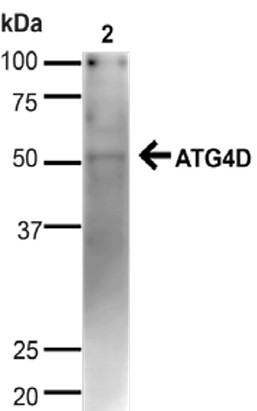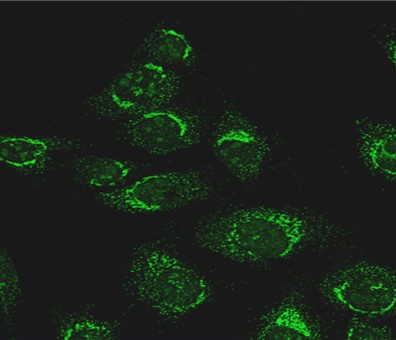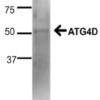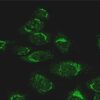Anti-Atg4D Antibody (23003)
$466.00
SKU: 23003
Categories: Antibody Products, Autophagy Antibodies, Products
Overview
Product Name Anti-Atg4D Antibody (23003)
Description Anti-Atg4D Rabbit Polyclonal Antibody
Target Atg4D
Species Reactivity Human
Applications WB,ICC/IF
Host Rabbit
Clonality Polyclonal
Immunogen Synthetic peptide corresponding to amino acids at the C-terminus of human Atg4D.
Properties
Form Liquid
Concentration 1.0 mg/mL
Formulation PBS, pH 7.4, 50% glycerol, 0.09% sodium azide.Concentration: 1mg/ml
Buffer Formulation Phosphate Buffered Saline
Buffer pH pH 7.4
Buffer Anti-Microbial 0.09% Sodium Azide
Buffer Cryopreservative 50% Glycerol
Format Purified
Purification Purified by peptide immuno-affinity chromatography
Specificity Information
Specificity This antibody recognizes human Atg4D.
Target Name Cysteine protease ATG4D
Target ID Atg4D
Uniprot ID Q86TL0
Alternative Names EC 3.4.22.-, AUT-like 4 cysteine endopeptidase, Autophagy-related cysteine endopeptidase 4, Autophagin-4, Autophagy-related protein 4 homolog D, HsAPG4D [Cleaved into: Cysteine protease ATG4D, mitochondrial]
Gene Name ATG4D
Sequence Location [Cysteine protease ATG4D]: Cytoplasm, Mitochondrion matrix
Biological Function [Cysteine protease ATG4D]: Cysteine protease that plays a key role in autophagy by mediating both proteolytic activation and delipidation of ATG8 family proteins (PubMed:21177865, PubMed:29458288, PubMed:30661429). The protease activity is required for proteolytic activation of ATG8 family proteins: cleaves the C-terminal amino acid of ATG8 proteins MAP1LC3 and GABARAPL2, to reveal a C-terminal glycine (PubMed:21177865). Exposure of the glycine at the C-terminus is essential for ATG8 proteins conjugation to phosphatidylethanolamine (PE) and insertion to membranes, which is necessary for autophagy (By similarity). In addition to the protease activity, also mediates delipidation of ATG8 family proteins (PubMed:29458288, PubMed:33909989). Catalyzes delipidation of PE-conjugated forms of ATG8 proteins during macroautophagy (PubMed:29458288, PubMed:33909989). Also involved in non-canonical autophagy, a parallel pathway involving conjugation of ATG8 proteins to single membranes at endolysosomal compartments, by catalyzing delipidation of ATG8 proteins conjugated to phosphatidylserine (PS) (PubMed:33909989). ATG4D plays a role in the autophagy-mediated neuronal homeostasis in the central nervous system (By similarity). Compared to other members of the family (ATG4A, ATG4B or ATG4C), constitutes the major protein for the delipidation activity, while it promotes weak proteolytic activation of ATG8 proteins (By similarity). Involved in phagophore growth during mitophagy independently of its protease activity and of ATG8 proteins: acts by regulating ATG9A trafficking to mitochondria and promoting phagophore-endoplasmic reticulum contacts during the lipid transfer phase of mitophagy (PubMed:33773106). {UniProtKB:Q8BGV9, UniProtKB:Q9Y4P1, PubMed:21177865, PubMed:29458288, PubMed:30661429, PubMed:33773106, PubMed:33909989}.; [Cysteine protease ATG4D, mitochondrial]: Plays a role as an autophagy regulator that links mitochondrial dysfunction with apoptosis. The mitochondrial import of ATG4D during cellular stress and differentiation may play important roles in the regulation of mitochondrial physiology, ROS, mitophagy and cell viability. {PubMed:19549685, PubMed:22441018}.
Research Areas Autophagy
Background Autophagy is a catabolic process that results in the degradation of bulk cytoplasmic contents within autophagosomes and lysosomes. Recent studies demonstrated that Atg4D is a substrate for caspase-3 during apoptosis. Truncated Atg4D has increased priming and delipidation effects on the Atg8 paralogue GABARAP-L1 in vitro and induces cell death when overexpressed in human cells. In addition, Atg4D-mediated apoptosis is facilitated by a putative C-terminal BH3 domain and is preceded by recruitment of Atg4D to mitochondria, suggesting that Atg4D plays an important role at the interface between autophagy and apoptosis.
Application Images



Description Immunoblotting: use at 1-2ug/ml. A band of ~52kDa is detected. Detection of Atg4D in 20ug HeLa cell lysate.

Description Immunofluorescence: use at 10ug/ml. Detection of Atg4D in formaldehyde-fixed C2C12 cells.
Handling
Storage This antibody is stable for at least one (1) year at -20°C.
Dilution Instructions Dilute in PBS or medium that is identical to that used in the assay system.
Application Instructions Immunoblotting: use at 1-2ug/mL. A band of ~52kDa is detected.
Immunofluorescence: use at 10ug/mL.
These are recommended concentrations.
Endusers should determine optimal concentrations for their applications.
Immunofluorescence: use at 10ug/mL.
These are recommended concentrations.
Endusers should determine optimal concentrations for their applications.
References & Data Sheet
Data Sheet  Download PDF Data Sheet
Download PDF Data Sheet
 Download PDF Data Sheet
Download PDF Data Sheet





